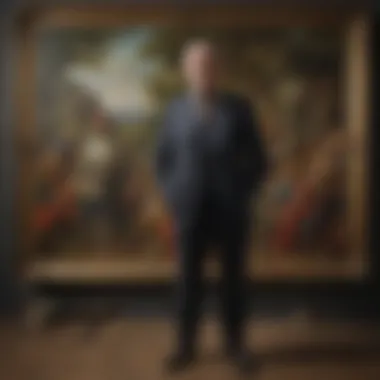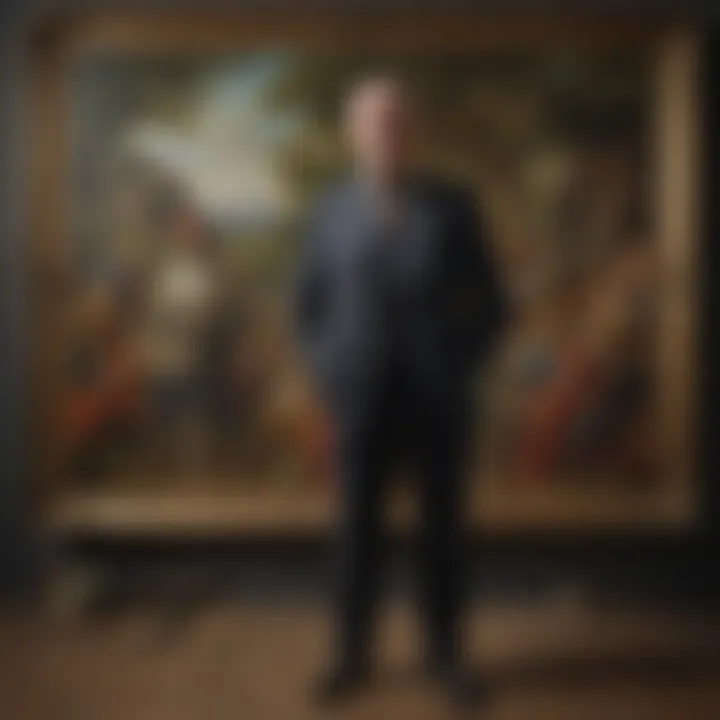Exploring the Legacy of Male Painters in Art History


Intro
Art history is often perceived through lenses shaped by the predominant figures who defined eras and movements. Male painters have significantly influenced this landscape, contributing not only to the evolution of styles but also to broader cultural dialogues. This article seeks to delve into the complexities of their legacies within the art world, addressing how their contributions have navigated through cultural, social, and economic contexts.
Understanding the role of male painters is crucial for appreciating how artistic expression has transformed over time. By examining both well-known artists like Pablo Picasso and Vincent van Gogh, alongside lesser-known figures, we aim to present a rounded view of their impact.
Key Concepts and Terminology
Definition of Key Terms
- Legacy: The lasting influence or effect of an artist’s work on future generations and movements in art.
- Art Movements: Distinct periods or trends in art characterized by particular styles, philosophies, and shared objectives among artists.
- Cultural Context: The environment in which an artist operates, including societal norms, economic conditions, and historical influences.
Concepts Explored in the Article
- The relationship between male painters and the societal structures that supported their work.
- The influence of male painters on contemporary discussions about gender representation in the arts.
- An examination of the nuances in legacies of both celebrated and overlooked male artists.
Findings and Discussion
Main Findings
This exploration reveals that male painters have not only shaped artistic techniques but also reflect the socio-political issues of their times. The scrutiny of their works can unlock deeper understandings of the dynamics that affect not only art but also societal narratives.
Potential Areas for Future Research
Further research could focus on how contemporary gender dynamics might redefine the interpretation of past artworks. There is also the potential to investigate the intersection of male painters with emerging art movements that challenge traditional structures.
"Examining the contributions of male painters illuminates not only their individual talents but also the cultural architectures that either supported or hindered their work throughout history."
Prelims to Male Painters
The role of male painters in the evolution of art history is multifaceted and significant. This article aims to illuminate their contributions, shedding light on their impact across various artistic movements. The discussion will address not only the masterpieces created but also the societal frameworks and cultural contexts that have shaped these artists' works.
In appreciating the legacy of male painters, it's crucial to consider the historical backdrop. Men have traditionally occupied prominent positions in the art world, which has allowed their works to gain visibility and influence. Examining this dominance also provides insight into the historical perception of gender roles within the artistic community. Notably, as we explore this legacy, we must question the dynamics of power and privilege that may have marginalized female artists and their contributions.
Understanding the influence of male painters encompasses more than their aesthetic achievements. It involves an inquiry into how cultural standards and societal expectations have affected their development. By studying figures such as Leonardo da Vinci, Vincent van Gogh, and Pablo Picasso, we can uncover varying styles, techniques, and philosophies that define their work.
Additionally, examining the motivations behind their creations sheds light on the broader societal themes. Often, these artists acted as commentators on their times, reflecting societal changes, political movements, and economic transformations through their art. This connection between the artist and the prevailing culture underlines the importance of their narratives within art history.
Thus, this introduction sets the stage for a deeper exploration. Recognizing the impact male painters have made enriches our understanding of not only their legacies but also the evolving discourse on representation and diversity in contemporary art.
"The study of art history is a reflection of the society that produces it; understanding male painters is key to understanding the socio-cultural narrative of art itself."
Historical Context of Male Painters
Understanding the historical context of male painters is vital to comprehend their contributions to art across ages. This context provides insight into the circumstances that shaped their work, their influences, and the reception of their art. Male painters have frequently been at the forefront of artistic movements, and their legacies are often intertwined with broader societal narratives.
The role of male painters is often viewed through the lens of power dynamics, education, and accessibility to resources. Historically, men had more opportunities for training and patronage, resulting in a significant imbalance in representation. Recognizing this allows for a critical examination of who has been elevated in the art world and why. It also sheds light on the ongoing dialogue about gender representation in the arts today.
Role of Men in Artistic Tradition
Men have been the predominant figures in artistic traditions over centuries. From the masters of the Renaissance to contemporary influencers, male painters have continuously shaped art’s trajectory. With institutions and art schools predominantly catering to male artists, the narrative of art in history is often male-centered. This raises questions about the criteria for artistic merit and how societal values influence this perception.


Some notable aspects of the role men have played in artistic traditions include:
- Training and Education: Access to education played a key role in defining male painters' successes.
- Patronage System: Male artists often received commissions and support from influential patrons, securing their positions in art history.
- Exhibition Opportunities: Art exhibitions have historically favored male artists, impacting whose work is spotlighted.
Impact of Societal Norms
Societal norms have shaped the perceptions of masculinity within art. The expectation for male painters to exhibit strength, genius, and emotional detachment has colored not only art creation but also public reception. Society has often celebrated male artists based on these traits, reinforcing stereotypes.
The impacts of these norms are long-standing:
- Gender Stereotypes: Male artists are often perceived as authoritative figures, while female artists face barriers.
- Artistic Themes: Many pieces by male painters reflect traditional masculine perspectives, influencing trends in subject matter and style.
- Cultural Legacy: The glorification of male artists continues to influence contemporary art discussions.
"The narratives constructed around male painters carry substantial weight in understanding the evolution of art and its societal implications."
Famous Male Painters and Their Contributions
The influence of male painters on art history is undeniable. Their contributions shape not only individual movements but also the evolution of art as a whole. Explaining the nuances of their work allows for a better insight into the cultural and social fabric of their time. This section dives into renowned male painters from different eras and styles, highlighting their unique contributions.
The Renaissance Masters
Leonardo da Vinci
Leonardo da Vinci stands as a hallmark of the Renaissance with his multifaceted genius. His ability to combine art with scientific inquiry is profound. Da Vinci’s mastery in depicting human anatomy and light set new standards in painting. His work on The Last Supper demonstrates not just technical skill but also an understanding of narrative and emotion. This makes him a vital figure in this article. His unique ability to blend various disciplines further emphasizes how interconnected art and science can be.
Michelangelo
Michelangelo's skill in sculpture, painting, and architecture showcases an artistic versatility that few can match. His iconic works, especially David and the Sistine Chapel ceiling, reflect not only his technical prowess but also his innovative approach to form and space. These characteristics make Michelangelo a significant entry in this article. His unique style combines classical ideals with a highly personal expression, often conveying deep emotional resonance through his figures.
Raphael
Raphael's talent lies in his harmonious compositions and graceful figures. His contribution to the Renaissance is marked by an emphasis on clarity and balance, which can be seen in works like The School of Athens. This particular aspect of his art makes him an appealing figure for discussion. His unique ability to integrate various influences into a cohesive style sets a standard for future generations, making his inclusion important for understanding the era's evolution.
Baroque Influences
Caravaggio
Caravaggio revolutionized the depiction of light and shadow in art, bringing realism to a new level. His use of chiaroscuro creates dramatic tension in works such as Judith Beheading Holofernes. Caravaggio’s ability to evoke emotion through the physicality of his subjects is a crucial aspect of his contribution. His unique approach forces viewers to confront the raw intensity of human experience, making his study vital within the context of this article.
Rembrandt
Rembrandt is recognized for his innovative use of light and his profound ability to capture human emotion. His portraits often reveal the complexities of his subjects, giving a psychological depth that was unique for his time. In this article, Rembrandt's skill in creating intimate narratives elevates his significance. His works, like The Night Watch, also demonstrate how he transformed the traditional notions of portraiture and group composition.
Vermeer
Vermeer, though less prolific, has left an indelible mark on the art world. His meticulous attention to details and mastery of light is evident in paintings like Girl with a Pearl Earring. Vermeer’s ability to evoke stillness and contemplation makes his work a noteworthy choice. His unique portrayal of domestic scenes gives insight into the lives of his subjects, inviting observers to reflect on their narratives.
Modern Innovators
Van Gogh
Van Gogh’s emotional intensity and bold color palette revolutionized post-impressionism. His works like Starry Night reflect his inner turmoil and passion. Van Gogh’s approach to expressive brushwork sets him apart, making him an essential figure for this article. His unique contribution combines personal experience with broader artistic innovations, which led to future movements like Expressionism.


Picasso
Picasso is a pioneering figure in modern art, known for co-founding the Cubist movement. The innovative methods seen in works such as Les Demoiselles d'Avignon mark the beginning of a new way of seeing, dismantling traditional perspectives. This critical aspect ensures Picasso's relevance in discussions of male painters' legacies. His ability to shift forms and styles throughout his career speaks to the dynamism present in modern art.
Dali
Salvador Dali’s surrealist works, such as The Persistence of Memory, challenge reality and perceptions. His exploration of the subconscious mind expands the boundaries of artistic expression. Dali’s unique style combines meticulous detail with bizarre imagery, making him a fascinating figure for consideration. His contributions encourage reflections on dreams and the human psyche, thus broadening the scope of art history discussion.
Diversity Among Male Painters
Diversity is a crucial element in the study of male painters. It provides a broader understanding of how different cultural and social backgrounds influence artistic expression. The importance of recognizing this diversity lies not only in celebrating various styles and techniques but also in understanding how historical context influenced the careers of male painters.
Cultural Backgrounds and Styles
Different cultural backgrounds lead to distinct artistic styles. For instance, the influences on a painter from Italy can vastly differ from those on an artist from Japan or Mexico. The diversity among male painters enriches the tapestry of art history. Artists like Francisco Goya, from Spain, expressed political and social commentary through his dark and dramatic paintings. In contrast, Henri Matisse, a leader in the Fauvist movement, used vibrant colors to evoke emotions without adhering to traditional representations. This cultural variance contributes to a wider array of artistic movements, enabling art to evolve continuously.
Moreover, understanding different styles allows us to appreciate not just the artwork but the socio-political climates that shaped these men's experiences. The incorporation of elements from the artist’s cultural heritage can serve as a powerful tool of expression and identity.
Geographical Variance in Artistic Output
Geographical differences also play a vital role in the diversity of male painters. Art from Europe can look fundamentally different from that of Asia or Africa due to historical influences, available materials, and artistic traditions. For instance, while European artists often emphasized perspective and realism, Qiu Ying, a Chinese painter from the Ming dynasty, used intricate ink techniques in a manner distinctly different from European practices.
The emergence of art movements across various regions, such as Impressionism in France or Abstract Expressionism in the United States, showcases the localized responses to societal changes and technological advancements. Such variance highlights how geography informs not just the subject matter of paintings but also the underlying philosophies and themes.
"Art is a reflection of humanity. To understand it, one must consider the many perspectives that shape an artist’s vision."
This understanding not only enriches the dialogue surrounding art but also fosters appreciation for the unique contributions made by male painters from diverse backgrounds. Recognizing this diversity emphasizes that art should not be viewed through a singular lens but rather as a multifaceted experience shaped by myriad cultures and geographical influences.
The Economic Aspects of Male Painters
Understanding the economic factors that influenced male painters provides significant insight into their development and success in the art world. Throughout history, art has often been intertwined with wealth and power, impacting who gets supported and how their work is perceived. Financial backing can dictate much, from the availability of materials to the freedom for artists to innovate. It is vital to explore these economic aspects to grasp the full legacy of male painters and their contributions to art.
Patronage in the Art World
Patronage has played a crucial role in the careers of many male painters. Wealthy individuals, institutions, and even royalty have historically commissioned works from artists, providing them both financial support and social status. This relationship created a system where art often reflected the tastes and preferences of affluent patrons rather than the artists’ personal vision.
- Key patrons such as popes, kings, and merchants shaped the trajectory of art movements. For instance, the Medicis were notable patrons in Florence, commissioning works from Renaissance figures like Leonardo da Vinci and Michelangelo.
- The influence of patronage is evident in the themes and subjects represented in many artworks. When artists relied on commissions, their work often featured religious themes or flattering portraits of their patrons, rather than experimental or personal expressions.
- Additionally, the rise of art academies in the 17th and 18th centuries led to more structured avenues for emerging male artists. These institutions offered not only training but also a network of patrons, further shaping the careers of many.
Market Trends and Male Artists
The market dynamics surrounding male painters have evolved over the centuries, reflecting broader economic conditions and cultural shifts. Understanding these trends can provide clarity on how certain artists rose to fame or fell into obscurity.
- Art auctions and galleries have emerged as significant platforms for male artists to sell their work. The commercialization of art began to take hold in the 19th century, offering opportunities for broader exposure and wider audiences.
- Shifts in demand can also impact an artist’s legacy. For example, Impressionist painters like Claude Monet initially struggled for acceptance but later became highly sought after as market preferences changed.
- Furthermore, the growth of the art market has led to increasing competition among male painters. The economic pressures of supply and demand can sometimes overshadow the artistic intent, pushing some artists to create commercially viable work at the expense of their original vision.
In summary, the economic aspects surrounding male painters not only highlight their struggles and successes but also allow for a deeper appreciation of the societal structures that shaped their art. From the patronage system that sustained many to the market trends that influenced their legacy, economics play a vital role in understanding the narrative of male painters throughout history.
Political and Social Influences
The role of political and social influences in the legacy of male painters is intricate and multifaceted. This discussion explores how these aspects shape artistic expression and impact the reception of art across different eras. Male painters not only reflect the cultural contexts of their time but also actively engage with the sociopolitical landscapes. Their works often serve as a commentary on societal issues, resonating with viewers across generations.
Art as a Political Tool


Art possesses a unique capability to convey messages that may not be expressed openly in political discourse. Male painters have historically utilized their skill to act as instruments of change. Notable examples include Diego Rivera, whose murals exhibited strong communist themes, highlighting class struggle and social injustice. Similarly, Francisco Goya painted politically charged works, critiquing the effects of war and human suffering.
The relationship between art and politics manifests in several prominent ways:
- Advocacy and Activism: Many male painters embrace their platforms to advocate for social change. Their art critiques authority and challenges the status quo.
- Censorship and Resistance: Throughout history, artists have faced censorship, driving them to find innovative methods of portraying political views within their work.
- Visual Propaganda: Governments have commissioned male painters to produce pieces that promote national ideologies or glorify specific historical narratives.
These factors illustrate how male painters employ their art not just as an aesthetic experience, but as a means to influence thought and provoke dialogue within the public sphere.
Male Painters and Social Commentary
The tradition of social commentary in the works of male painters ranges from subtle reflections on societal norms to explicit critiques of injustice. Artists like Édouard Manet tackled contentious issues such as class disparity and gender roles, reflecting the tensions of modern life in their art.
Social commentary can take various forms, including:
- Realism: Male painters like Gustave Courbet showcased the lives of ordinary people, exposing the raw truths of society.
- Expressionism: Artists such as Edvard Munch used intense color and emotions to highlight existential struggles and societal crisis.
- Feminism and Gender Roles: Some male painters have critically engaged with gender dynamics in their work, exploring the representation of women in art and society.
"Art enables us to find ourselves and lose ourselves at the same time." – Thomas Merton. This quote reflects the dual nature of art – as an exploration of self and as a mirror reflecting societal issues.
By critically examining these elements, one can better understand how male painters contribute to social dialogues and how their legacies continue to evolve as society grapples with contemporary issues. The complexities of their work reveal layers of meaning that encourage deeper engagement with the art itself, allowing audiences to reflect on cultural implications.
Contemporary Perspectives on Male Painters
The significance of examining contemporary perspectives on male painters lies in the evolving discourse surrounding their legacies. In a world increasingly aware of gender dynamics, the reevaluation of male artists is necessary for a balanced understanding of art history. This exploration reveals multiple layers of influence; not only do we assess their contributions through the lens of traditional achievements but also consider how they fit into modern discussions of representation and diversity.
The study of contemporary perspectives on these painters is beneficial in several ways. First, it allows us to critically engage with their historical context, challenging the long-held notions about gender in art. Second, it fosters awareness regarding the gaps that exist in the narratives we share about art. Lastly, it encourages a more inclusive approach to art history.
Reassessment of Their Legacies
Reassessing the legacies of male painters involves unpacking intricate narratives surrounding their works and lives. While figures like Leonardo da Vinci and Vincent van Gogh are celebrated for their artistic brilliance, it is essential to consider a broader context. Their personal struggles, societal influences, and the dynamics of power in their eras shaped not just their art, but also how they are viewed today.
An important aspect of this reassessment is recognizing the contributions of lesser-known male artists. Often overshadowed by the titans of art history, these individuals have unique stories that merit attention. By acknowledging them, the art community can create a more nuanced narrative that reflects diversity not just in gender, but in style and impact.
"To understand art is to understand the complex layers of time, society, and identity that influence every creative act."
This quotation highlights the importance of context in appreciating the artistry of male painters. It prompts discussions about their relevance in today's creative landscape and urges scholars and enthusiasts to broaden the criteria used to evaluate artistic merit.
Diversity and Inclusion in Modern Art
The call for diversity and inclusion in modern art movements can no longer be ignored. Today's artists, regardless of gender, are pushing boundaries and redefining traditional norms. Male painters are part of this conversation as they navigate their histories and societal expectations. They confront the artists' role in challenging or perpetuating stereotypes.
To foster inclusivity, there have been initiatives aimed at amplifying voices from various backgrounds. Programs and exhibitions that feature underrepresented artists highlight the multifaceted experiences within the arts community. This emphasis on diversity may transform how art history is perceived and taught.
In summary, the contemporary perspectives on male painters invite a critical reconsideration of their legacies. Such exploration not only enriches our understanding of their contributions but also emphasizes the need for diverse voices in the narrative of art history.
End
The examination of male painters within the context of art history reveals profound insights into their contributions, influence, and legacy. It is essential to recognize the lasting impact these artists have had across different movements and periods. Understanding their roles assists not only in grasping the evolution of artistic styles but also in understanding the cultural dialogues they sparked during their respective eras.
The stories of these male painters offer valuable perspectives regarding how gender and societal influences have shaped artistic expression. This analysis highlights that their influence is not solely tied to their individual styles. Instead, it often intertwines with broader currents of thought reflecting political, social, and economic conditions of their times.
The Enduring Influence of Male Painters
To comprehend the enduring influence of male painters, one must assess their roles in shaping contemporary art and thought. These painters have established frameworks that today’s artists continue to reference, critique, or dismantle. The legacy of figures like Leonardo da Vinci and Vincent van Gogh reveals not only their innovative techniques but also how their styles entered the collective consciousness of artists and audiences alike.
Much of today's art discourse grapples with the implications of these historical contributions.
- Cultural Reflection: Male painters have often mirrored the societal challenges of their times, encouraging dialogue around themes such as identity, power, and existence.
- Artistic Techniques: Their mastery of techniques has provided foundational learning for generations of artists. Many modern methods stem from the practices pioneered by these significant figures.
- Registered Impact: Each artist has a unique narrative. Their personal stories often reflect the broader human experience, creating a link between past and present.
In sum, recognizing the enduring influence of male painters is crucial for engaging with both historical context and modern artistic practice. This exploration emphasizes the necessity of incorporating diverse perspectives to enhance our understanding of art in all its forms.







